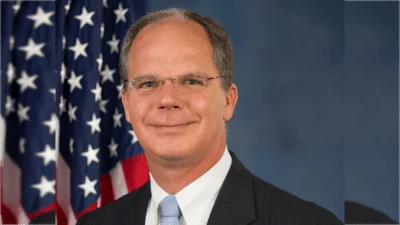Dear Secretary Leavitt:
On Aug. 16, 2007, we wrote to you regarding statements being made by the Administration on its ability to deny state plan amendments (SPAs) to make clear that the Administration’s reasoning is flawed and inconsistent with the requirements of the State Children’s Health insurance Program
(CHIP) in and prescribed in Title XXI of the Social Security Act (SSA). Since you have not responded to our letter, and the Administration persists in making incorrect statements about its authority to deny state plan amendments, specifically New York’s state plan amendment, we are writing again to underscore the correct reading of the authority given to the Secretary in the Social Security Act.
The Administration’s statement that the CHIP reauthorization bill, H.R. 976, makes the Secretary powerless to deny New York’s state plan amendment to cover children in families with incomes up to $83,000 is flatly incorrect. Likewise, for the same reasons, claims that the CHIP reauthorization bill expands coverage to children in families with incomes up to $83,000 are also incorrect. Current law gives the Secretary ample authority and justification to deny New York’s state plan amendment and the compromise CHIP reauthorization bill passed by Congress does nothing to change this underlying authority. The law is very clear that the Secretary has the ultimate authority to make sure that states, through their state plans and state plan amendments, implement coverage for low-income children in CHIP in compliance with the requirements of Title XXI. This authority exists regardless of the validity or continued effect of the CMS August 17 letter to state health officers regarding crowd-out. Moreover, the CHIP reauthorization bill does not amend the eligibility requirements of Title XXI in any way so claims that the bill expands eligibility are plainly false.
As you know, New York submitted a state plan amendment (SPA) that proposes to allow the state to expand eligibility for children under the State Children’s Health Insurance Plan (CHIP) up to
400% of the federal poverty level (FPL) ($82,600 a year for a family of four). New York’s Medicaid eligibility is currently 200% FPL ($41,300 a year for a family of four) for infants, 133% FPL
($27,464.50 a year for a family of four) for 1-5 year olds and 100% FPL ($20,650 a year for a family of four) for 6-18 year olds.
We are aware that under guidance issued to states in a State Health Official (SHO) letter sent last Aug. 17, 2007, the New York plan was not approved and while the department used the August
17 SHO letter as the basis for denying New York’s state plan amendment, the August 17 SHO letter is not the sole justification available to disapprove the New York plan. We are disappointed and perplexed by reports that the Department is of the view that absent the August 17 SHO letter, the Administration is powerless to disapprove New York’s plan, should that plan be resubmitted. As our Aug. 16, 2007 letter outlined, to raise eligibility beyond the plain meaning of “low income" and expand eligibility another 200 percentage points above the Medicaid eligibility limit for infants is in direct conflict with both the legislative language in Title XXI and the intent of Congress and that the Secretary of HHS has the express legal authority to disapprove this plan.
First, section 2101 defines the purpose of CHIP as providing “child health assistance to uninsured,
low-income children...." and under 2101(b), states are not eligible for any payments without an approved state plan that establishes how the state intends to provide health coverage “to needy children" consistent with the requirements of Title XXI. The clear meaning of Section 2101 directs that CHIP be implemented as a program limited to low-income children. As made clear in section
2101(b)(2), the state’s plan must be approved by the secretary under section 2106.
Section 2102(b)(1) of the social security act establishes the eligibility standards that states must follow in their state plans for CHIP. Pursuant to Section 2102(b)(1)(A) a state plan, submitted for approval to the Secretary “shall include a description of the standards used to determine the eligibility of targeted low income children for child health assistance under the plan."
Section 2106(b), provides for the submission and approval by the secretary of a state plan and any subsequent state plan amendment except, pursuant to Section 2106(e) if the Secretary finds,
“substantial noncompliance of the plan with the requirements of this title." The requirements of this Title here refer to the requirements of Title XXI, including the requirement that Title XXI funds are only available to provide assistance that is limited to health coverage for “uninsured low-income children," under section 2101(a), and that meet the eligibility standards for “low-income" children,
under section 2102(b)(1). Moreover, this provision plainly states that state plans are subject to the approval of the Secretary.
For purposes of determining the limits of eligibility for coverage in a state plan (or state plan amendment) under CHIP, Congress provided definitions of “low-income" in the law. Section
2110(b) provides the definition of “targeted low-income child" as a child “who is a low-income child" or a child whose family income exceeds the threshold for Medicaid eligibility “but does not exceed 50 percentage points above the Medicaid applicable income level." And “low-income child"
is defined in 2110(c) (4) as “a child whose family income is at or below 200 percent of the poverty line for a family of the size involved."
Congress provided the correct interpretation of these statutory definitions of “low-income" in The Conference Report accompanying the Balanced Budget Act of 1997 (Report 105-217) in which CHIP was enacted. the conference report outlined that Section 2110 of Title XXI of the Social Security Act, “defines targeted low income children as those who (1) meet the eligibility standards as determined by the state, (2) reside in families with income below 200% of the federal poverty level or in states with Medicaid applicable income levels at, above, or less than 50 percentage points below 200% of poverty at the date of enactment, below the Medicaid applicable income level increased by no more than 50 percentage points."
As we stated in our letter of Aug. 16, if Congress had not intended the 200% FPL limit to be an actual limitation on eligibility, then there would have been no need for Congress to explicitly provide for the possibility of CHIP coverage of an additional 50 percentage points above certain state's Medicaid eligibility. Moreover, if Congress had not intended for the Secretary to have authority to disapprove state plan amendments expanding eligibility to any level, then the income limitations in the law and the 50 percentage point additional option for certain states would have been unnecessary.
It is correct that states are permitted some flexibility in the eligibility standards they define in their state plan. Under 2102(b)(1)(A), a state’s eligibility standards “may include (to the extent consistent with this title) those relating to... Income and resources (including any standards relating to spenddowns and disposition of resources)." Congress made clear, however, that this flexibility to the states was only permitted as long as it is “consistent with this title," meaning that standards relating to spenddowns and resources, must be consistent with the purpose of the CHIP program,
that is providing “child health assistance to uninsured low-income children,"(section 2101(a))
(emphasis added).
While Congress was clear that the purpose of CHIP is providing coverage to low-income children below 200% of the poverty level, Title XXI does not provide a strict numerical threshold for what income levels, inclusive of income disregards, a state may ultimately use in making an eligibility determination. Because states do have limited flexibility under 2102(b)(1)(A) to establish standards related to income disregards, previous Administrations have approved state plans that included a liberal interpretation of this flexibility. That flexibility, however, is not infinite. For the Administration to claim that it is powerless to deny a state plan amendment that proposes to effectively expand eligibility through the use of income disregards is tantamount to saying that the ability of the states to use income disregards actually is infinite. That conclusion, on its face, is absurd.
Since the use of income disregards is plainly not limitless, by not providing an unambiguous limit,
Congress left to the Secretary the authority to make the determination of how far states can go in applying this flexibility. As already described above, Section 2102(b)(1)(A) clearly directs the Secretary to make sure that states only exercise this flexibility in a manner that is consistent with CHIP’s purpose of covering low-income children.
Once again, Section 2106(c) of the Social Security Act, titled “Disapproval of Plans and Plan Amendments" clearly provides the Secretary’s authority to disapprove a state plan.
Further, Section 2106(c)(2) of the Social Security Act expressly stipulates that the Secretary may
“notify the State in writing, within 90 days after receipt of the plan or amendment, that the plan or amendment is disapproved (and the reasons for disapproval) or that specified additional information is needed." Again, the statute clearly contemplates that certain state plan amendments will be disapproved.
The approval of a state plan amendment (SPA), therefore, is not a foregone conclusion. As we stated in our August 16 letter, there have been several state plan amendments that have been disapproved.
For purposes of clarity, we will provide again here the following is a description, which was prepared by officials from the Centers for Medicare and Medicaid Services (CMS), of some state plan amendments that have not been approved:
1. In March 8, 2004, Texas submitted a ninth amendment to transition the coverage of car seats from an outreach program under its administrative cap to a child health assistance benefit under its Secretary approved SCHIP benefit package. CMS disapproved the amendment on 12/15/04 with the rationale that car seats would be more appropriately characterized as a health services initiative funded under the administrative cap and not as child health assistance.
2. On Sept. 28, 2005, Texas submitted its thirteenth amendment proposing to modify the cost sharing requirements for families with incomes from 133 percent through 150 percent of the federal poverty level (FPL) by replacing current monthly premiums with a $25 enrollment fee every six months upon initial enrollment and re-enrollment. Because the $25 enrollment fee exceeded the aggregate monthly amounts allowed by the SCHIP regulations for enrollees at or below 150 percent of the FPL, the SPA was disapproved on Dec. 23, 2005.
3. On June 29, 2004, Virginia submitted a SPA to add some school-based services to the SCHIP State Plan. A request for additional information was sent to the State on Aug. 18, 2004 and the
90-day review clock was stopped. The State never responded to the request for additional information and the SPA was disapproved on April 20, 2007. On June 22, 2007, the State requested a reconsideration of the disapproval. A hearing on the State's request is scheduled for September 4,
2007 in Philadelphia.
Given this list of state plan amendments that this Administration has disapproved for relatively minor deviations from the law, we cannot determine an appropriate argument in support of this Administration’s position that it is powerless to disapprove a state plan that this Administration and many others strenuously believe represents a significant departure from the intent of Title XXI. The Administration has repeatedly argued that the $82,600 CHIP eligibility standard for a family of four proposed in the New York state plan amendment does not meet the definition of low-income. While previous Administrations have permitted states to disregard substantial sums of income in determining eligibility, an argument that the current Administration is powerless to undo policies established by a prior Administration has no merit given this administration’s disregard of numerous policies established by the previous Administration. A few examples illustrate this point.
1. In 1989, Congress enacted Section 6411(g) of the Omnibus Budget Reconciliation Act of 1989
(P.L. 101-239). This provision of law clearly states that “Secretary of Health and Human Services may not... withhold, suspend, disallow, or deny Federal financial participation under section
1903(a) of the Social Security Act for day habilitation and related services: Yet, in the notice of proposed rulemaking (NPRM) with respect to Medicaid coverage of rehabilitative services that was published in the Federal Register on Aug. 13, 2007, CMS appears to be proposing to require states that had approved day habilitation services as part of their State plans on or before June 30,
1989, to make significant changes to the provisions of those services which effectively ends day habilitation services in those states.
2. Regarding previous Administration policies relative to CHIP: Timothy Westmoreland, Director,
Health Care Financing Administration, under the Clinton Administration sent a letter to state health officials in July, 2000, providing guidance on Clinton Administration policies relative to parent and childless adult coverage under CHIP. Outlined in this letter was the policy relating to section 1115 demonstration authority to give states the ability to expand coverage to other populations, notably,
parents of CHIP eligible children and pregnant women. The policy of the Clinton Administration was that in order to secure these waivers, a state must be covering children up to age 19 with family incomes up to at least 200% FPL. In contrast, under this Administration, waivers have been approved to allow states that only cover children up to 185% FPL to cover parents and childless adults with CHIP funds.
3. Additionally, it was established that the policy of the Clinton Administration relative to childless adults was to, “not consider demonstration proposals to cover other adults without children." Under this Administration, six states have received approval to cover childless adults.
4. Regarding previous Administration polices relative to intergovernmental transfers (IGTs): over the last 5 years, this Administration has systematically restructured financial relationships between the states and the federal government by changing the rules relating to intergovernmental transfers
(IGTs). This Administration required states to restructure payments to providers through IGTs even though the IGTs were approved by the prior Administration and were arguably legal under existing law.
Given how aggressively the Administration acted and the broad range of regulatory authority this Administration assumed with IGTs and in many other areas, it is inconsistent, indeed inconceivable,
that this same administration now claims to have “no authority to disapprove amendments solely based on income disregards" as in the case of the New York state plan amendment for CHIP.
In conclusion, current law makes it very clear that the Secretary has the ultimate authority to ensure that states adhere to the purpose of CHIP, determine what qualifies as low-income and then, through the approval or denial of state plans and state plan amendments, make sure that states comply with eligibility standards that are consistent with the purpose of program, to cover low-income children.
Nothing in the CHIP reauthorization bill passed by Congress changes one word of the law that is outlined above. This clear authority existed in the law on Aug. 16, when we first wrote to you on this subject, continued to exist after the issuance of the CMS August 17 SHO letter, and would not be altered by the compromise agreement. While the compromise agreement does supplant the flawed August 17 policies on crowd-out and replace them with more reasoned policies, the very clear authority residing in the Secretary to approve or disapprove proposed state plan amendments based on the proper application of eligibility standards would remain untouched.
Therefore, pursuant to Section 2106 of the Social Security Act, which is left untouched by the compromise CHIP reauthorization agreement, the Secretary has the clear and undeniable authority to disapprove New York’s state plan amendment. The Secretary has the authority to make sure that state methodologies for determining income are consistent with the purpose of Section 2101 of the Social Security Act, “to provide funds to states to enable them to initiate and expand the provision of child health assistance to uninsured low income children." And as stated above, a methodology that exceeds the plain meaning of "low-income" by proposing to implement excessive income disregards goes beyond congressional intent and therefore should be disapproved. This is true regardless of whether the August 17 policies in the SHO letter remain in effect or not.
As we have not received a response from you, we are requesting that your Office of General Counsel meet with our staff on these issues. Specifically, that meeting should encompass a review of your authority to deny state plan amendments that violate the law and the extent of your authority to properly interpret the statute and implement the requirements put forward by Congress. We would appreciate hearing why, even absent the August 17 SHO letter, that this Administration would feel compelled to approve any state plan amendment, including the New York state plan amendment when the law, legislative history, and your own repeated assertions all support the argument that CHIP is intended for low-income children.
Thank you for your prompt consideration of this request.
Sincerely,
Charles E. Grassley
Ranking Member
Pat Roberts Committee Member
-30-









